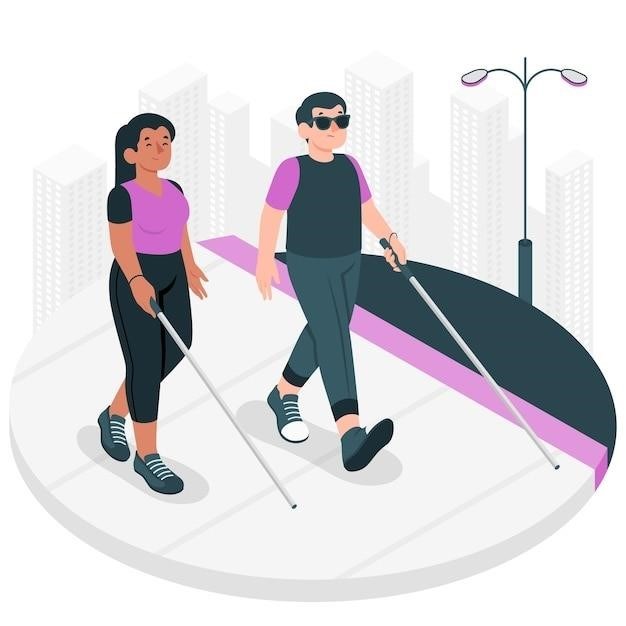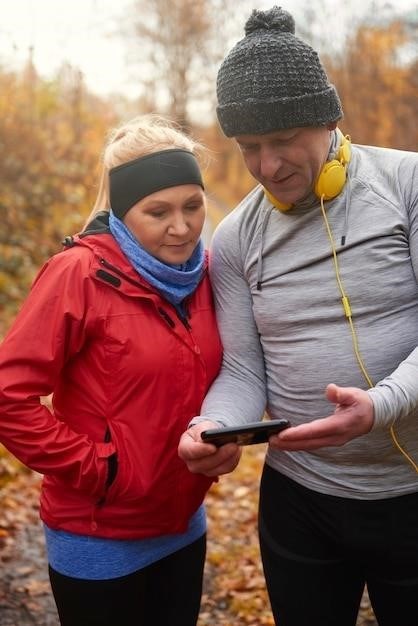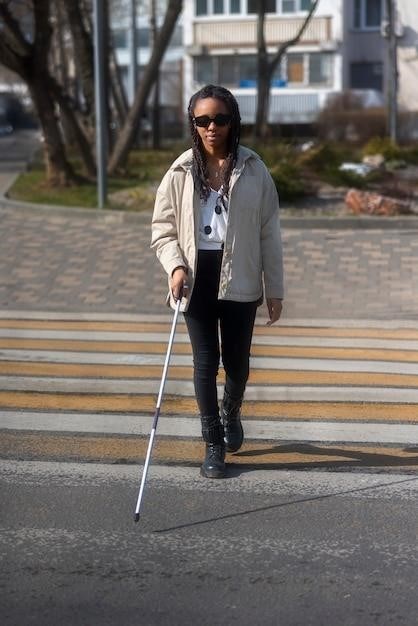visually impaired running guide
Visually Impaired Running Guide⁚ A Comprehensive Guide
This guide provides a comprehensive overview of visually impaired running, covering the benefits, types of visual impairment, the role of guide runners, training, communication, equipment, finding a guide, and the importance of trust and communication․ It also explores the benefits for both the runner and guide, and includes resources and organizations for further support․
Introduction
Running is a beloved pastime for many, offering a multitude of physical and mental benefits․ However, for individuals with visual impairments, the joy of running can seem out of reach․ Fortunately, the world of running has embraced inclusivity, creating a vibrant community where visually impaired athletes can thrive with the support of dedicated guide runners․ This guide delves into the world of visually impaired running, providing insights into the benefits, challenges, and essential considerations for both runners and guides․
Visually impaired running encompasses a spectrum of abilities, from those with partial vision to those who are completely blind․ The level of visual impairment determines the type of support needed, ranging from verbal cues to physical guidance․ The core principle, however, remains the same⁚ to provide a safe and empowering running experience that allows visually impaired athletes to reach their full potential․ This guide will explore the diverse world of visually impaired running, from the fundamentals of guide running to the profound impact it has on the lives of both runners and guides․
Benefits of Running with a Guide
Running with a guide offers a plethora of benefits for visually impaired athletes, extending beyond the physical advantages to encompass mental, emotional, and social well-being․ The most obvious benefit is safety․ With a guide by their side, visually impaired runners can navigate diverse terrains, including crowded streets, uneven paths, and challenging obstacles, with confidence․ The guide provides crucial information about the environment, alerting the runner to potential hazards and ensuring a secure and enjoyable running experience․
Beyond safety, running with a guide opens doors to a world of opportunities․ Visually impaired runners can participate in races, join running groups, and explore new trails, fostering a sense of independence and inclusion․ The presence of a guide creates a shared experience, fostering camaraderie and a sense of community․ Moreover, the physical benefits of running are amplified, as the guide can help the runner maintain proper form, pace, and technique, leading to improved fitness and overall well-being․ The partnership between runner and guide creates a unique bond, empowering visually impaired athletes to embrace the joy and challenge of running․
Types of Visual Impairment and Guide Running
The spectrum of visual impairment is vast, ranging from mild vision loss to complete blindness․ Understanding the different types of visual impairment is crucial for guide runners to effectively support their athletes․ Individuals with low vision may have difficulty seeing details, reading, or navigating in low light, while those with blindness experience complete or near-complete vision loss․ The level of visual impairment significantly impacts the runner’s needs and the role of the guide․
Guide running accommodates a wide range of visual impairments․ For runners with partial vision, the guide may provide verbal cues and assistance with navigating obstacles․ Runners with complete blindness rely heavily on the guide for direction, pace, and safety․ The guide’s role adapts to the specific needs of the athlete, ranging from providing verbal guidance to physical support during challenging terrain․ Communication is key, ensuring that the runner and guide are on the same page, fostering trust and a seamless running experience․
Guide running transcends the limitations of visual impairment, enabling athletes to reach their full potential and participate in running activities on equal footing with sighted individuals․ The guide’s role is not simply to navigate the runner but to create an inclusive and supportive environment where the runner can thrive․
The Role of the Guide Runner
The guide runner plays a vital role in enabling visually impaired athletes to enjoy the benefits of running․ More than just a navigator, the guide is a trusted partner, providing safety, encouragement, and a shared passion for the sport․ Their responsibilities encompass a range of aspects, ensuring the athlete’s well-being and success․
A guide’s primary responsibility is to ensure the athlete’s safety․ This involves navigating obstacles, providing verbal cues about the course, and maintaining a steady pace․ The guide must be aware of their surroundings, anticipating potential hazards and communicating them clearly to the athlete․ This requires excellent situational awareness and a strong understanding of the course․
Beyond safety, the guide provides crucial support and motivation․ They help set the pace, provide encouragement, and offer a sense of companionship during training and races․ The guide’s role extends beyond physical guidance; it encompasses emotional support and a shared commitment to achieving the athlete’s goals․
The guide runner is an integral part of the visually impaired runner’s success, enabling them to experience the joy and challenges of running with confidence and independence․
Training and Preparation
Training for visually impaired running requires a collaborative effort between the athlete and their guide, ensuring both are prepared for the challenges ahead․ This involves a combination of physical conditioning, communication practice, and understanding the unique demands of running with a guide․ The training process is not just about physical fitness; it’s about building trust and understanding between the runner and guide․
Physical conditioning is essential for both the athlete and guide․ The guide needs to be able to maintain a steady pace and navigate the course safely, while the athlete needs to build endurance and strength․ Training sessions should include intervals, hill work, and long runs to prepare for race conditions․ The guide should also be aware of the athlete’s fitness level and adjust the pace accordingly․
Communication is paramount․ The guide should be able to clearly and concisely communicate information about the course, including obstacles, changes in terrain, and upcoming turns․ The athlete, in turn, should communicate their needs and any discomfort they experience․ Regular communication practice, both during training and races, is crucial to ensure a smooth and safe running experience․
Training also involves understanding the specific needs of the visually impaired runner; The guide should be aware of the runner’s visual impairment, the type of cues they require, and their preferred running style․ This understanding allows the guide to tailor their guidance to the individual athlete, ensuring a comfortable and effective training process․
Communication and Safety
Effective communication is the cornerstone of safe and enjoyable running for visually impaired athletes and their guides․ It’s a constant dialogue that ensures the runner is aware of their surroundings, potential obstacles, and changes in the course․ This communication goes beyond simple verbal cues; it encompasses a shared understanding of their roles and responsibilities․
The guide should be constantly aware of their surroundings, providing clear and concise information about the course․ This includes describing upcoming turns, changes in terrain, obstacles, and potential hazards․ The guide should use descriptive language, ensuring the runner has a clear mental picture of the path ahead․ Regular communication throughout the run helps the runner feel secure and confident․
The visually impaired athlete should also actively communicate with their guide․ They should inform the guide about any changes in their comfort level, physical limitations, or any concerns they have about the course․ Open communication ensures that the guide can adjust their pace, modify their guidance, or take necessary precautions to ensure the runner’s safety․
Safety is paramount․ The guide should be vigilant, ensuring the runner’s path is clear and free from obstacles․ They should be aware of potential hazards, such as uneven terrain, traffic, or other runners․ Both the guide and the runner should be aware of their surroundings and respond appropriately to any unexpected situations․ This constant vigilance helps to minimize risks and promote a safe running experience․
Equipment and Techniques

Running with a visual impairment requires specific equipment and techniques to ensure safety and efficiency․ The most common piece of equipment is a tether, a lightweight cord that connects the guide and runner․ It provides a physical connection, allowing the runner to follow the guide’s movements and stay in sync․ The tether should be adjustable in length to accommodate different paces and running styles․
Verbal cues play a crucial role in communication․ The guide provides clear and concise instructions about the course, indicating turns, obstacles, and changes in terrain․ They may use phrases like “left turn,” “obstacle ahead,” or “speed up․” The runner should be comfortable with these cues and respond accordingly․ The guide should also be aware of the runner’s pace and adjust their own accordingly․
Hand-holding techniques are another vital element․ The guide may hold the runner’s wrist, allowing for gentle guidance and direction․ This technique is particularly useful during tight turns or when navigating crowded areas․ The guide should be mindful of the runner’s comfort level and adjust their grip accordingly․
The guide should also be aware of their own running style and adjust it to suit the runner’s needs․ If the runner has a faster pace, the guide should adapt their stride accordingly․ If the runner prefers a shorter stride, the guide should adjust their own to maintain a consistent rhythm․ This coordination ensures a smooth and enjoyable running experience․
Finding a Guide Runner
Finding a suitable guide runner is crucial for visually impaired runners․ There are several avenues to explore⁚
- Local Running Clubs⁚ Many running clubs have volunteer guide runners who are trained and experienced in supporting visually impaired athletes․ Contact your local club to inquire about their guide runner program or if they have a list of individuals willing to guide․
- Sight Loss Societies⁚ Reach out to your local sight loss society․ They often have networks of guide runners or can connect you with individuals who are interested in volunteering․
- Online Platforms⁚ Websites like United In Stride provide a self-service platform for blind and low vision athletes to connect with guides․ This platform allows for direct communication, establishing a connection based on shared running goals and preferences․
- Achilles International⁚ This organization specializes in supporting athletes with disabilities, including visually impaired runners․ They offer training programs and resources for both runners and guides․ You can explore their website to find potential guide runners or volunteer opportunities․
When searching for a guide runner, it’s essential to consider factors such as experience, running pace, communication skills, and personal compatibility․ It’s recommended to meet with potential guides to discuss your running goals, training preferences, and expectations for the partnership․
The Importance of Trust and Communication
Trust and communication are fundamental to a successful and safe partnership between a visually impaired runner and their guide․ Building a strong foundation of trust allows the runner to feel secure and confident in their guide’s ability to navigate the course safely and effectively․ This trust is built through open communication and a shared understanding of each other’s needs and expectations․
Effective communication is essential during every aspect of the running experience, from pre-race planning to the actual run itself․ Clear and consistent communication helps ensure a smooth and enjoyable run․ The guide should provide verbal cues about the terrain, obstacles, and any changes in direction․ The runner should also communicate their pace preferences, any physical limitations, and any concerns or anxieties they may have․
Beyond the physical aspects of running, building a trusting relationship allows for emotional support and encouragement․ Sharing goals, overcoming challenges, and celebrating successes together strengthens the bond between the runner and guide, fostering a sense of camaraderie and mutual respect․
Benefits for Both Runner and Guide
The partnership between a visually impaired runner and their guide offers numerous benefits for both individuals․ For the runner, having a guide opens up a world of possibilities, allowing them to experience the joy and physical benefits of running without the limitations of their vision impairment․ They can participate in races, explore new trails, and push their personal boundaries, knowing they have a trusted companion to guide them safely․
For the guide, the experience is equally rewarding․ It provides a unique opportunity to contribute to someone else’s well-being and fitness goals․ Guide runners often report feeling a sense of purpose and fulfillment, knowing they are making a positive impact on the lives of visually impaired individuals․ It can also be a physically and mentally challenging experience, requiring focus, stamina, and the ability to adapt to different running conditions․
Beyond the physical and mental benefits, the relationship between runner and guide can foster strong bonds of friendship and camaraderie․ Sharing the experience of running together, overcoming challenges, and celebrating successes creates a sense of connection and mutual respect․ The partnership can be a truly transformative experience for both individuals, enriching their lives in ways they might not have imagined․
Running is a powerful activity that can benefit individuals of all abilities․ For visually impaired individuals, running with a guide provides a unique opportunity to experience the physical and mental rewards of this sport․ This guide has explored the various aspects of visually impaired running, from the benefits of running with a guide to the importance of trust and communication․ It has also highlighted the crucial role of guide runners in empowering visually impaired individuals to achieve their running goals․

Whether it’s training for a marathon, joining a local running group, or simply enjoying a leisurely jog, visually impaired runners can find fulfillment and joy in this activity․ The bond between runner and guide is essential to this experience, creating a partnership built on trust, respect, and shared goals․ By embracing the opportunities and challenges of visually impaired running, both runners and guides can contribute to a more inclusive and accessible world of running․
Remember, the journey of visually impaired running is not just about reaching the finish line, but about embracing the process, celebrating the achievements, and fostering a sense of community․ With the right support, resources, and a willingness to push boundaries, visually impaired individuals can achieve their running goals and find a deep sense of satisfaction and empowerment․
Resources and Organizations
For visually impaired individuals interested in running, there are a number of resources and organizations dedicated to providing support and guidance․ These resources can help connect runners with trained guide runners, provide training materials, and offer a sense of community and belonging․
Organizations like Achilles International, a global non-profit organization, work to empower individuals with disabilities to participate in running and other sports․ They offer a range of programs and resources, including finding a guide runner, training programs, and opportunities to participate in races․ The Bupa Foundation Community Grants also support visually impaired runners and walkers through organizations like Achilles Melbourne, providing funding for trail adventures and promoting inclusivity in the running community․
Additionally, local sight loss societies and running clubs often have programs and resources for visually impaired runners․ These organizations can provide valuable information about local events, training opportunities, and support groups․ Online platforms like United In Stride offer a self-service platform connecting blind and low-vision athletes with guides, fostering friendships and community building within the running world․
By exploring these resources and connecting with organizations that support visually impaired runners, individuals can find the tools and support they need to achieve their running goals and embrace the joys of this rewarding sport․

Leave a Reply
You must be logged in to post a comment.